Leadership and Management Attributes of Ratan Tata at Tata Group
VerifiedAdded on 2021/02/19
|10
|2799
|28
Report
AI Summary
This report critically evaluates the leadership and management attributes and skills of Ratan Tata, the chairman of the Tata Group. It explores his characteristics, including goal setting, direction, and motivation, alongside his management skills such as knowledge, confidence, and interpersonal skills. The report analyzes his visionary, creative, and risk-taking capabilities, highlighting how he inspires and influences employee behavior. Furthermore, it contrasts leadership and management theories adopted by Ratan Tata, such as autocratic, democratic, and laissez-faire styles, as well as the transformational leadership approach. The report also discusses management theories like the classical and scientific management approaches, illustrating how these theories are applied within the Tata Group to achieve organizational goals and enhance business image globally. The analysis is supported by relevant leadership and management theories, providing a comprehensive overview of Ratan Tata's impact on the Tata Group.
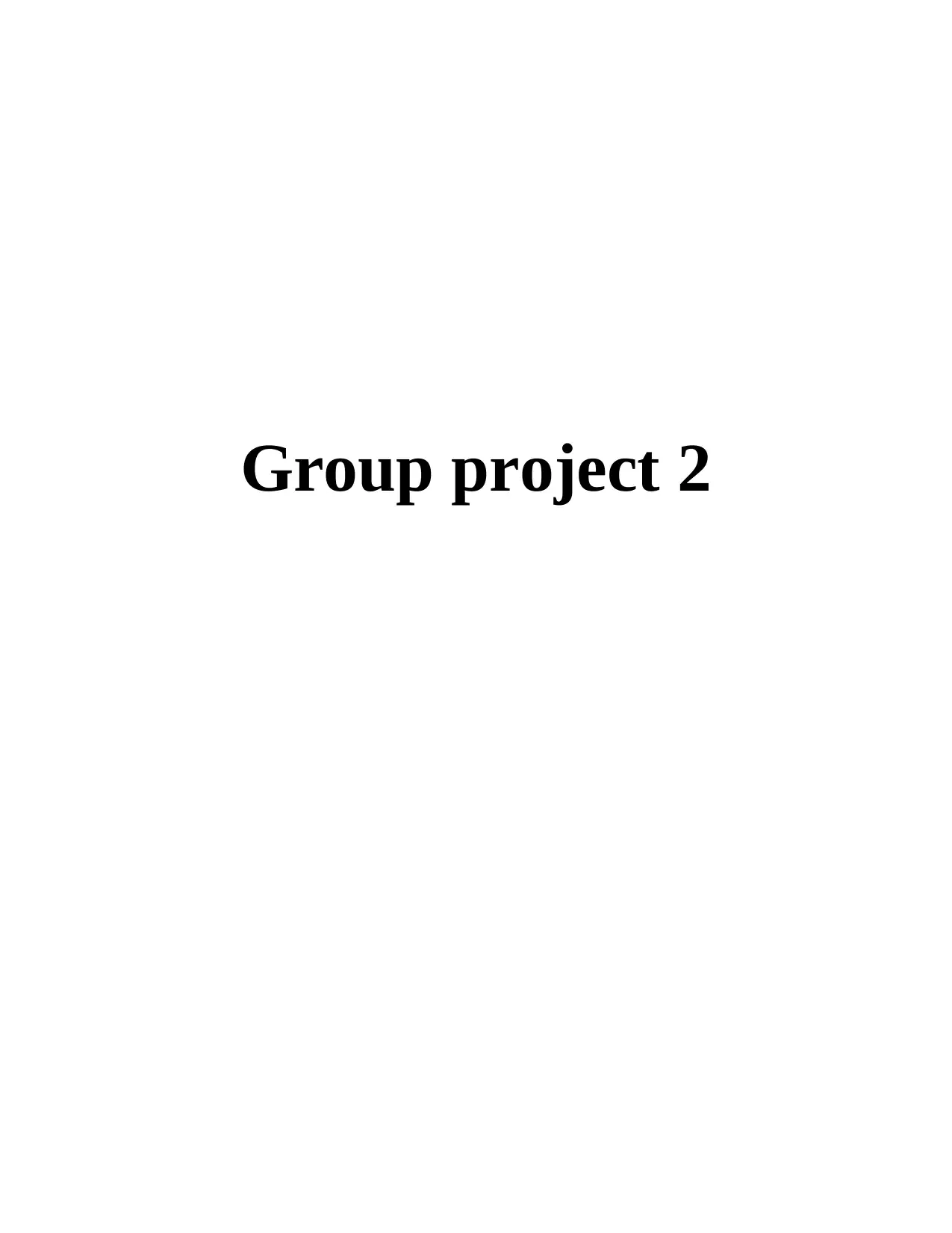
Group project 2
Paraphrase This Document
Need a fresh take? Get an instant paraphrase of this document with our AI Paraphraser
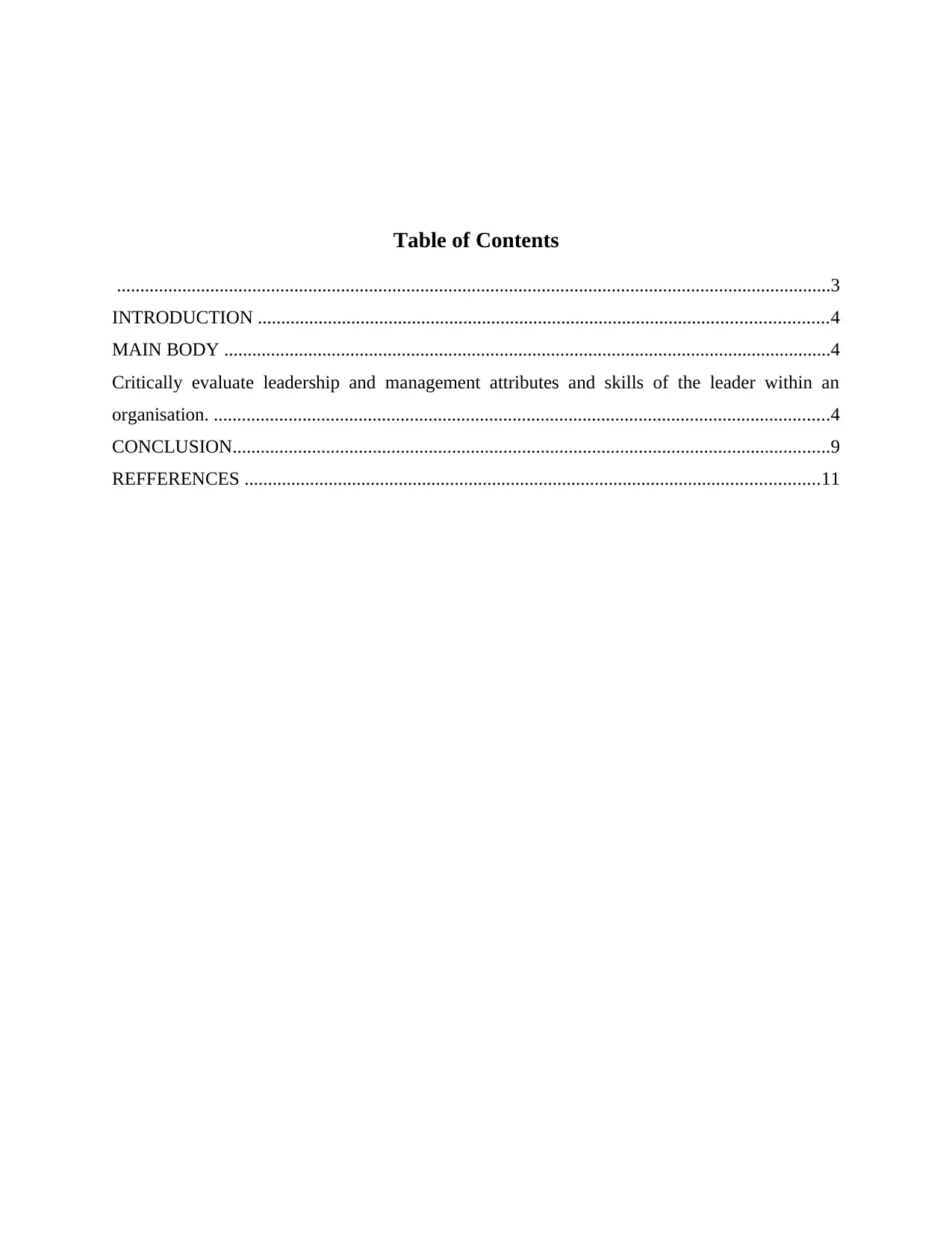
Table of Contents
.........................................................................................................................................................3
INTRODUCTION ..........................................................................................................................4
MAIN BODY ..................................................................................................................................4
Critically evaluate leadership and management attributes and skills of the leader within an
organisation. ....................................................................................................................................4
CONCLUSION................................................................................................................................9
REFFERENCES ...........................................................................................................................11
.........................................................................................................................................................3
INTRODUCTION ..........................................................................................................................4
MAIN BODY ..................................................................................................................................4
Critically evaluate leadership and management attributes and skills of the leader within an
organisation. ....................................................................................................................................4
CONCLUSION................................................................................................................................9
REFFERENCES ...........................................................................................................................11
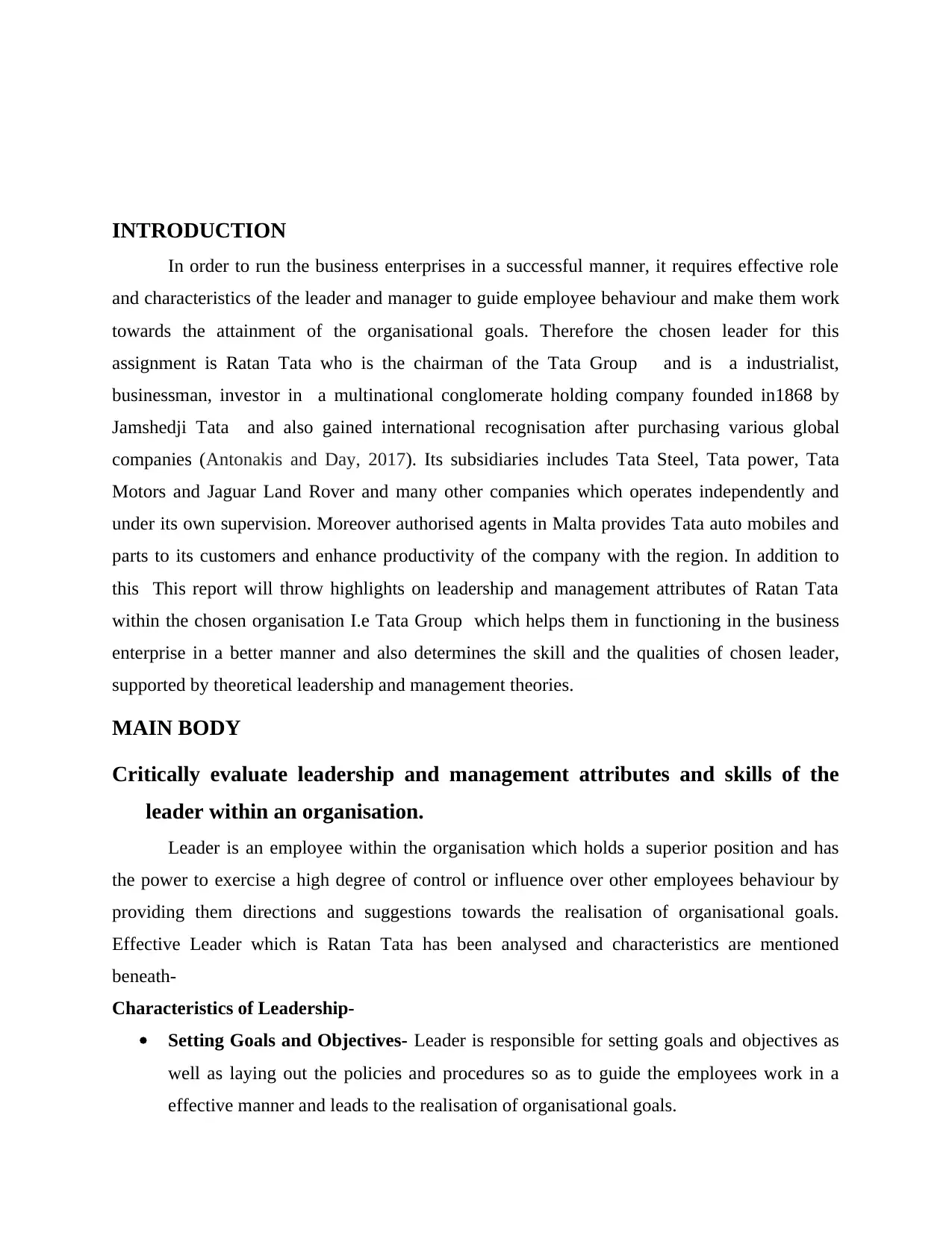
INTRODUCTION
In order to run the business enterprises in a successful manner, it requires effective role
and characteristics of the leader and manager to guide employee behaviour and make them work
towards the attainment of the organisational goals. Therefore the chosen leader for this
assignment is Ratan Tata who is the chairman of the Tata Group and is a industrialist,
businessman, investor in a multinational conglomerate holding company founded in1868 by
Jamshedji Tata and also gained international recognisation after purchasing various global
companies (Antonakis and Day, 2017). Its subsidiaries includes Tata Steel, Tata power, Tata
Motors and Jaguar Land Rover and many other companies which operates independently and
under its own supervision. Moreover authorised agents in Malta provides Tata auto mobiles and
parts to its customers and enhance productivity of the company with the region. In addition to
this This report will throw highlights on leadership and management attributes of Ratan Tata
within the chosen organisation I.e Tata Group which helps them in functioning in the business
enterprise in a better manner and also determines the skill and the qualities of chosen leader,
supported by theoretical leadership and management theories.
MAIN BODY
Critically evaluate leadership and management attributes and skills of the
leader within an organisation.
Leader is an employee within the organisation which holds a superior position and has
the power to exercise a high degree of control or influence over other employees behaviour by
providing them directions and suggestions towards the realisation of organisational goals.
Effective Leader which is Ratan Tata has been analysed and characteristics are mentioned
beneath-
Characteristics of Leadership-
Setting Goals and Objectives- Leader is responsible for setting goals and objectives as
well as laying out the policies and procedures so as to guide the employees work in a
effective manner and leads to the realisation of organisational goals.
In order to run the business enterprises in a successful manner, it requires effective role
and characteristics of the leader and manager to guide employee behaviour and make them work
towards the attainment of the organisational goals. Therefore the chosen leader for this
assignment is Ratan Tata who is the chairman of the Tata Group and is a industrialist,
businessman, investor in a multinational conglomerate holding company founded in1868 by
Jamshedji Tata and also gained international recognisation after purchasing various global
companies (Antonakis and Day, 2017). Its subsidiaries includes Tata Steel, Tata power, Tata
Motors and Jaguar Land Rover and many other companies which operates independently and
under its own supervision. Moreover authorised agents in Malta provides Tata auto mobiles and
parts to its customers and enhance productivity of the company with the region. In addition to
this This report will throw highlights on leadership and management attributes of Ratan Tata
within the chosen organisation I.e Tata Group which helps them in functioning in the business
enterprise in a better manner and also determines the skill and the qualities of chosen leader,
supported by theoretical leadership and management theories.
MAIN BODY
Critically evaluate leadership and management attributes and skills of the
leader within an organisation.
Leader is an employee within the organisation which holds a superior position and has
the power to exercise a high degree of control or influence over other employees behaviour by
providing them directions and suggestions towards the realisation of organisational goals.
Effective Leader which is Ratan Tata has been analysed and characteristics are mentioned
beneath-
Characteristics of Leadership-
Setting Goals and Objectives- Leader is responsible for setting goals and objectives as
well as laying out the policies and procedures so as to guide the employees work in a
effective manner and leads to the realisation of organisational goals.
⊘ This is a preview!⊘
Do you want full access?
Subscribe today to unlock all pages.

Trusted by 1+ million students worldwide
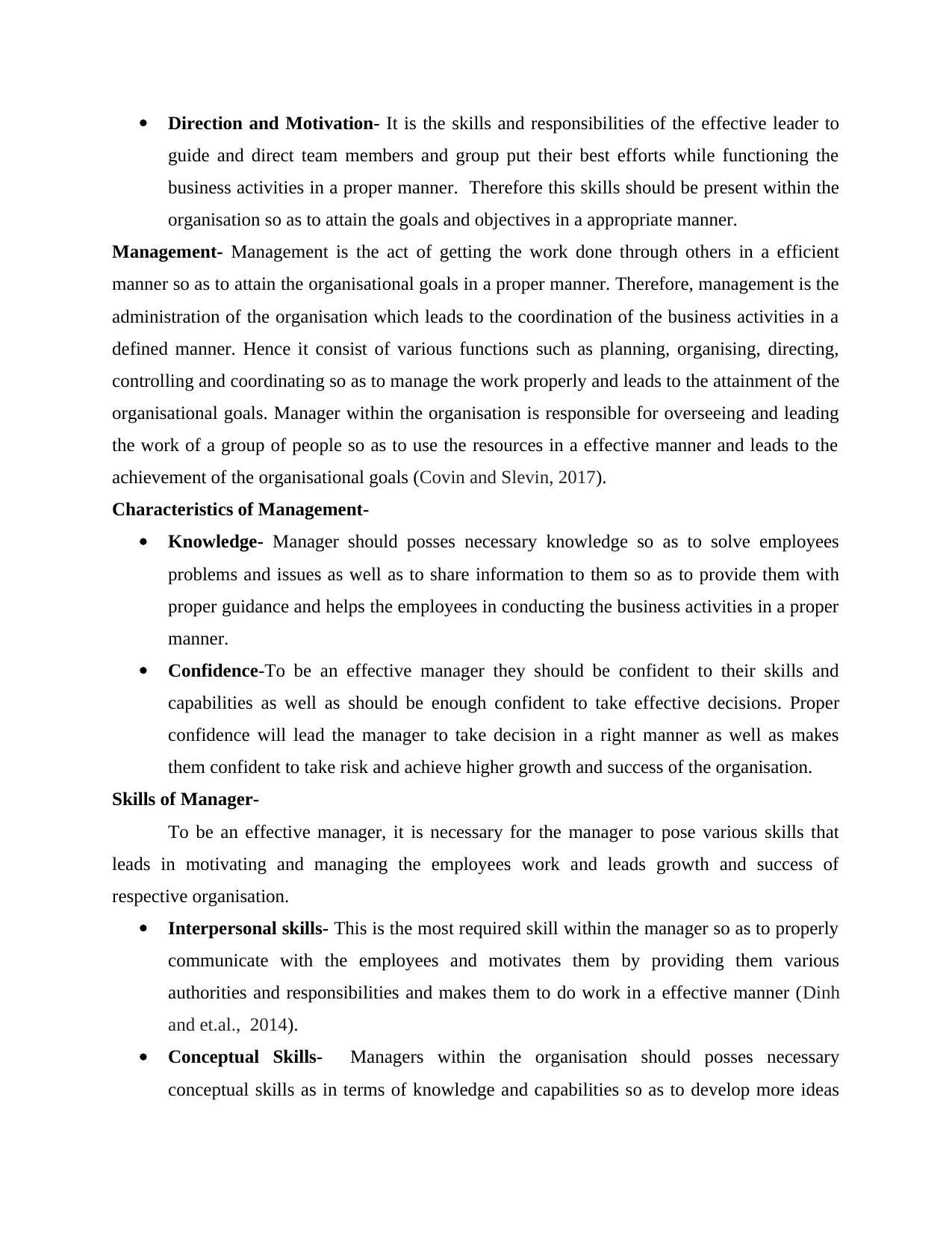
Direction and Motivation- It is the skills and responsibilities of the effective leader to
guide and direct team members and group put their best efforts while functioning the
business activities in a proper manner. Therefore this skills should be present within the
organisation so as to attain the goals and objectives in a appropriate manner.
Management- Management is the act of getting the work done through others in a efficient
manner so as to attain the organisational goals in a proper manner. Therefore, management is the
administration of the organisation which leads to the coordination of the business activities in a
defined manner. Hence it consist of various functions such as planning, organising, directing,
controlling and coordinating so as to manage the work properly and leads to the attainment of the
organisational goals. Manager within the organisation is responsible for overseeing and leading
the work of a group of people so as to use the resources in a effective manner and leads to the
achievement of the organisational goals (Covin and Slevin, 2017).
Characteristics of Management-
Knowledge- Manager should posses necessary knowledge so as to solve employees
problems and issues as well as to share information to them so as to provide them with
proper guidance and helps the employees in conducting the business activities in a proper
manner.
Confidence-To be an effective manager they should be confident to their skills and
capabilities as well as should be enough confident to take effective decisions. Proper
confidence will lead the manager to take decision in a right manner as well as makes
them confident to take risk and achieve higher growth and success of the organisation.
Skills of Manager-
To be an effective manager, it is necessary for the manager to pose various skills that
leads in motivating and managing the employees work and leads growth and success of
respective organisation.
Interpersonal skills- This is the most required skill within the manager so as to properly
communicate with the employees and motivates them by providing them various
authorities and responsibilities and makes them to do work in a effective manner (Dinh
and et.al., 2014).
Conceptual Skills- Managers within the organisation should posses necessary
conceptual skills as in terms of knowledge and capabilities so as to develop more ideas
guide and direct team members and group put their best efforts while functioning the
business activities in a proper manner. Therefore this skills should be present within the
organisation so as to attain the goals and objectives in a appropriate manner.
Management- Management is the act of getting the work done through others in a efficient
manner so as to attain the organisational goals in a proper manner. Therefore, management is the
administration of the organisation which leads to the coordination of the business activities in a
defined manner. Hence it consist of various functions such as planning, organising, directing,
controlling and coordinating so as to manage the work properly and leads to the attainment of the
organisational goals. Manager within the organisation is responsible for overseeing and leading
the work of a group of people so as to use the resources in a effective manner and leads to the
achievement of the organisational goals (Covin and Slevin, 2017).
Characteristics of Management-
Knowledge- Manager should posses necessary knowledge so as to solve employees
problems and issues as well as to share information to them so as to provide them with
proper guidance and helps the employees in conducting the business activities in a proper
manner.
Confidence-To be an effective manager they should be confident to their skills and
capabilities as well as should be enough confident to take effective decisions. Proper
confidence will lead the manager to take decision in a right manner as well as makes
them confident to take risk and achieve higher growth and success of the organisation.
Skills of Manager-
To be an effective manager, it is necessary for the manager to pose various skills that
leads in motivating and managing the employees work and leads growth and success of
respective organisation.
Interpersonal skills- This is the most required skill within the manager so as to properly
communicate with the employees and motivates them by providing them various
authorities and responsibilities and makes them to do work in a effective manner (Dinh
and et.al., 2014).
Conceptual Skills- Managers within the organisation should posses necessary
conceptual skills as in terms of knowledge and capabilities so as to develop more ideas
Paraphrase This Document
Need a fresh take? Get an instant paraphrase of this document with our AI Paraphraser
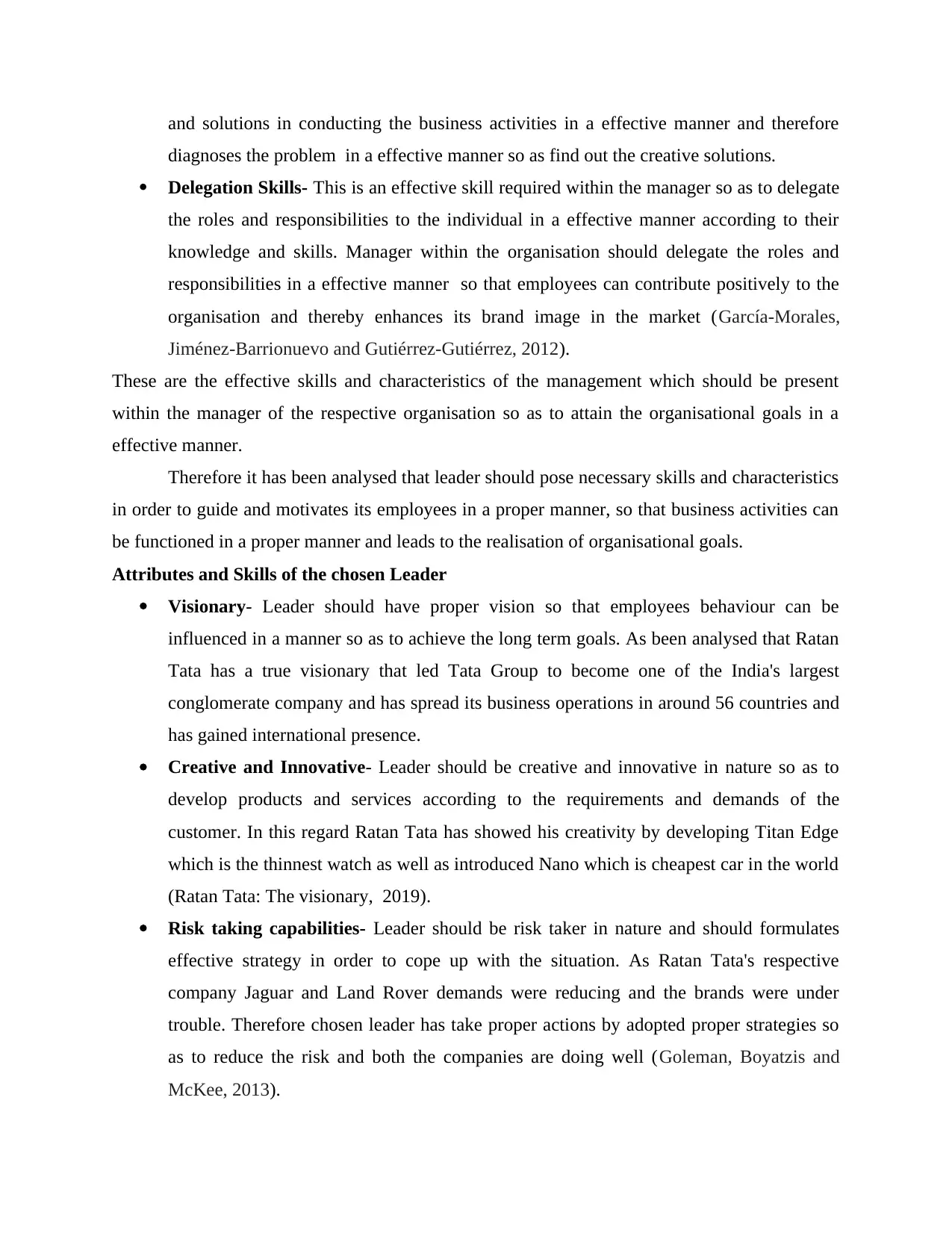
and solutions in conducting the business activities in a effective manner and therefore
diagnoses the problem in a effective manner so as find out the creative solutions.
Delegation Skills- This is an effective skill required within the manager so as to delegate
the roles and responsibilities to the individual in a effective manner according to their
knowledge and skills. Manager within the organisation should delegate the roles and
responsibilities in a effective manner so that employees can contribute positively to the
organisation and thereby enhances its brand image in the market (García-Morales,
Jiménez-Barrionuevo and Gutiérrez-Gutiérrez, 2012).
These are the effective skills and characteristics of the management which should be present
within the manager of the respective organisation so as to attain the organisational goals in a
effective manner.
Therefore it has been analysed that leader should pose necessary skills and characteristics
in order to guide and motivates its employees in a proper manner, so that business activities can
be functioned in a proper manner and leads to the realisation of organisational goals.
Attributes and Skills of the chosen Leader
Visionary- Leader should have proper vision so that employees behaviour can be
influenced in a manner so as to achieve the long term goals. As been analysed that Ratan
Tata has a true visionary that led Tata Group to become one of the India's largest
conglomerate company and has spread its business operations in around 56 countries and
has gained international presence.
Creative and Innovative- Leader should be creative and innovative in nature so as to
develop products and services according to the requirements and demands of the
customer. In this regard Ratan Tata has showed his creativity by developing Titan Edge
which is the thinnest watch as well as introduced Nano which is cheapest car in the world
(Ratan Tata: The visionary, 2019).
Risk taking capabilities- Leader should be risk taker in nature and should formulates
effective strategy in order to cope up with the situation. As Ratan Tata's respective
company Jaguar and Land Rover demands were reducing and the brands were under
trouble. Therefore chosen leader has take proper actions by adopted proper strategies so
as to reduce the risk and both the companies are doing well (Goleman, Boyatzis and
McKee, 2013).
diagnoses the problem in a effective manner so as find out the creative solutions.
Delegation Skills- This is an effective skill required within the manager so as to delegate
the roles and responsibilities to the individual in a effective manner according to their
knowledge and skills. Manager within the organisation should delegate the roles and
responsibilities in a effective manner so that employees can contribute positively to the
organisation and thereby enhances its brand image in the market (García-Morales,
Jiménez-Barrionuevo and Gutiérrez-Gutiérrez, 2012).
These are the effective skills and characteristics of the management which should be present
within the manager of the respective organisation so as to attain the organisational goals in a
effective manner.
Therefore it has been analysed that leader should pose necessary skills and characteristics
in order to guide and motivates its employees in a proper manner, so that business activities can
be functioned in a proper manner and leads to the realisation of organisational goals.
Attributes and Skills of the chosen Leader
Visionary- Leader should have proper vision so that employees behaviour can be
influenced in a manner so as to achieve the long term goals. As been analysed that Ratan
Tata has a true visionary that led Tata Group to become one of the India's largest
conglomerate company and has spread its business operations in around 56 countries and
has gained international presence.
Creative and Innovative- Leader should be creative and innovative in nature so as to
develop products and services according to the requirements and demands of the
customer. In this regard Ratan Tata has showed his creativity by developing Titan Edge
which is the thinnest watch as well as introduced Nano which is cheapest car in the world
(Ratan Tata: The visionary, 2019).
Risk taking capabilities- Leader should be risk taker in nature and should formulates
effective strategy in order to cope up with the situation. As Ratan Tata's respective
company Jaguar and Land Rover demands were reducing and the brands were under
trouble. Therefore chosen leader has take proper actions by adopted proper strategies so
as to reduce the risk and both the companies are doing well (Goleman, Boyatzis and
McKee, 2013).
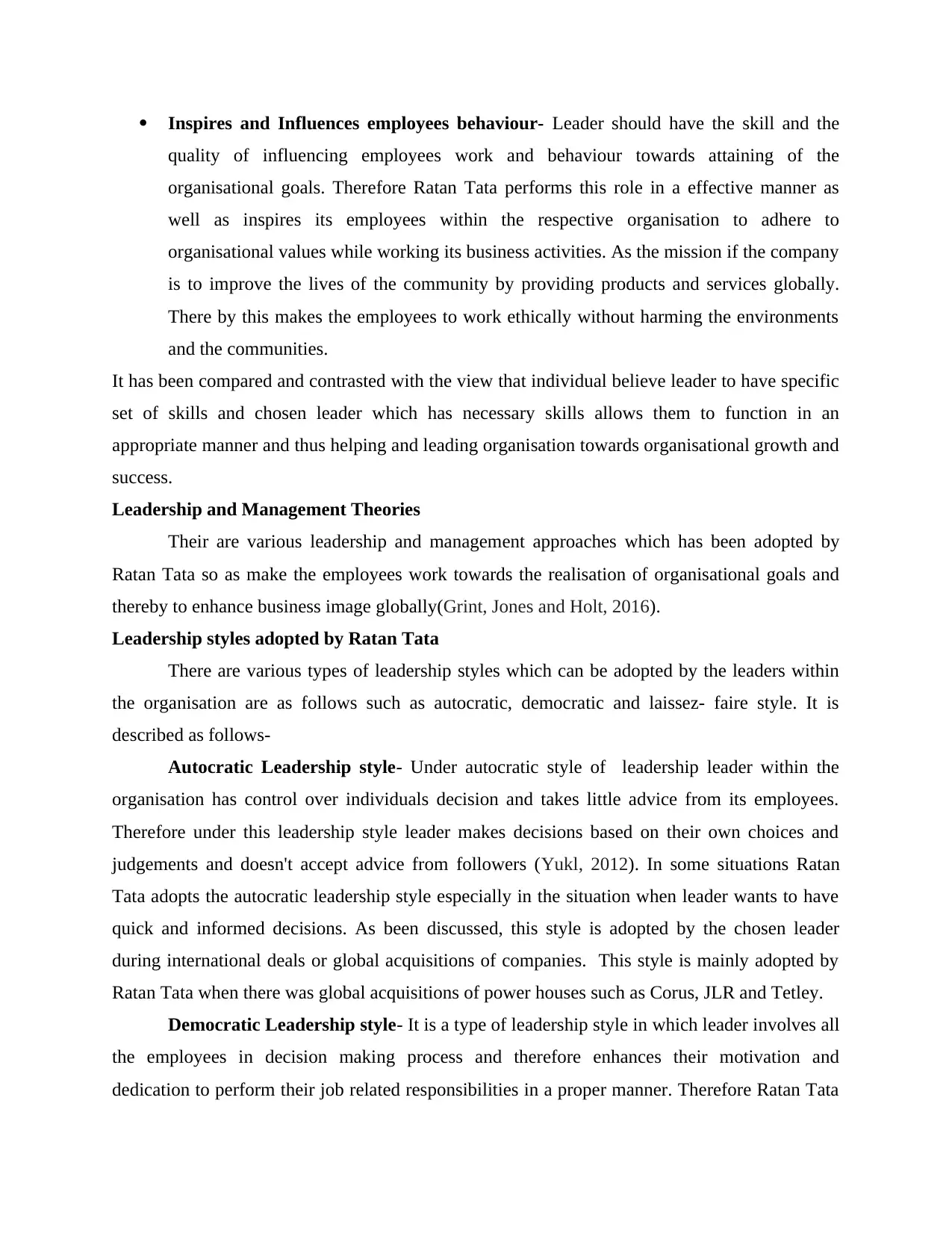
Inspires and Influences employees behaviour- Leader should have the skill and the
quality of influencing employees work and behaviour towards attaining of the
organisational goals. Therefore Ratan Tata performs this role in a effective manner as
well as inspires its employees within the respective organisation to adhere to
organisational values while working its business activities. As the mission if the company
is to improve the lives of the community by providing products and services globally.
There by this makes the employees to work ethically without harming the environments
and the communities.
It has been compared and contrasted with the view that individual believe leader to have specific
set of skills and chosen leader which has necessary skills allows them to function in an
appropriate manner and thus helping and leading organisation towards organisational growth and
success.
Leadership and Management Theories
Their are various leadership and management approaches which has been adopted by
Ratan Tata so as make the employees work towards the realisation of organisational goals and
thereby to enhance business image globally(Grint, Jones and Holt, 2016).
Leadership styles adopted by Ratan Tata
There are various types of leadership styles which can be adopted by the leaders within
the organisation are as follows such as autocratic, democratic and laissez- faire style. It is
described as follows-
Autocratic Leadership style- Under autocratic style of leadership leader within the
organisation has control over individuals decision and takes little advice from its employees.
Therefore under this leadership style leader makes decisions based on their own choices and
judgements and doesn't accept advice from followers (Yukl, 2012). In some situations Ratan
Tata adopts the autocratic leadership style especially in the situation when leader wants to have
quick and informed decisions. As been discussed, this style is adopted by the chosen leader
during international deals or global acquisitions of companies. This style is mainly adopted by
Ratan Tata when there was global acquisitions of power houses such as Corus, JLR and Tetley.
Democratic Leadership style- It is a type of leadership style in which leader involves all
the employees in decision making process and therefore enhances their motivation and
dedication to perform their job related responsibilities in a proper manner. Therefore Ratan Tata
quality of influencing employees work and behaviour towards attaining of the
organisational goals. Therefore Ratan Tata performs this role in a effective manner as
well as inspires its employees within the respective organisation to adhere to
organisational values while working its business activities. As the mission if the company
is to improve the lives of the community by providing products and services globally.
There by this makes the employees to work ethically without harming the environments
and the communities.
It has been compared and contrasted with the view that individual believe leader to have specific
set of skills and chosen leader which has necessary skills allows them to function in an
appropriate manner and thus helping and leading organisation towards organisational growth and
success.
Leadership and Management Theories
Their are various leadership and management approaches which has been adopted by
Ratan Tata so as make the employees work towards the realisation of organisational goals and
thereby to enhance business image globally(Grint, Jones and Holt, 2016).
Leadership styles adopted by Ratan Tata
There are various types of leadership styles which can be adopted by the leaders within
the organisation are as follows such as autocratic, democratic and laissez- faire style. It is
described as follows-
Autocratic Leadership style- Under autocratic style of leadership leader within the
organisation has control over individuals decision and takes little advice from its employees.
Therefore under this leadership style leader makes decisions based on their own choices and
judgements and doesn't accept advice from followers (Yukl, 2012). In some situations Ratan
Tata adopts the autocratic leadership style especially in the situation when leader wants to have
quick and informed decisions. As been discussed, this style is adopted by the chosen leader
during international deals or global acquisitions of companies. This style is mainly adopted by
Ratan Tata when there was global acquisitions of power houses such as Corus, JLR and Tetley.
Democratic Leadership style- It is a type of leadership style in which leader involves all
the employees in decision making process and therefore enhances their motivation and
dedication to perform their job related responsibilities in a proper manner. Therefore Ratan Tata
⊘ This is a preview!⊘
Do you want full access?
Subscribe today to unlock all pages.

Trusted by 1+ million students worldwide
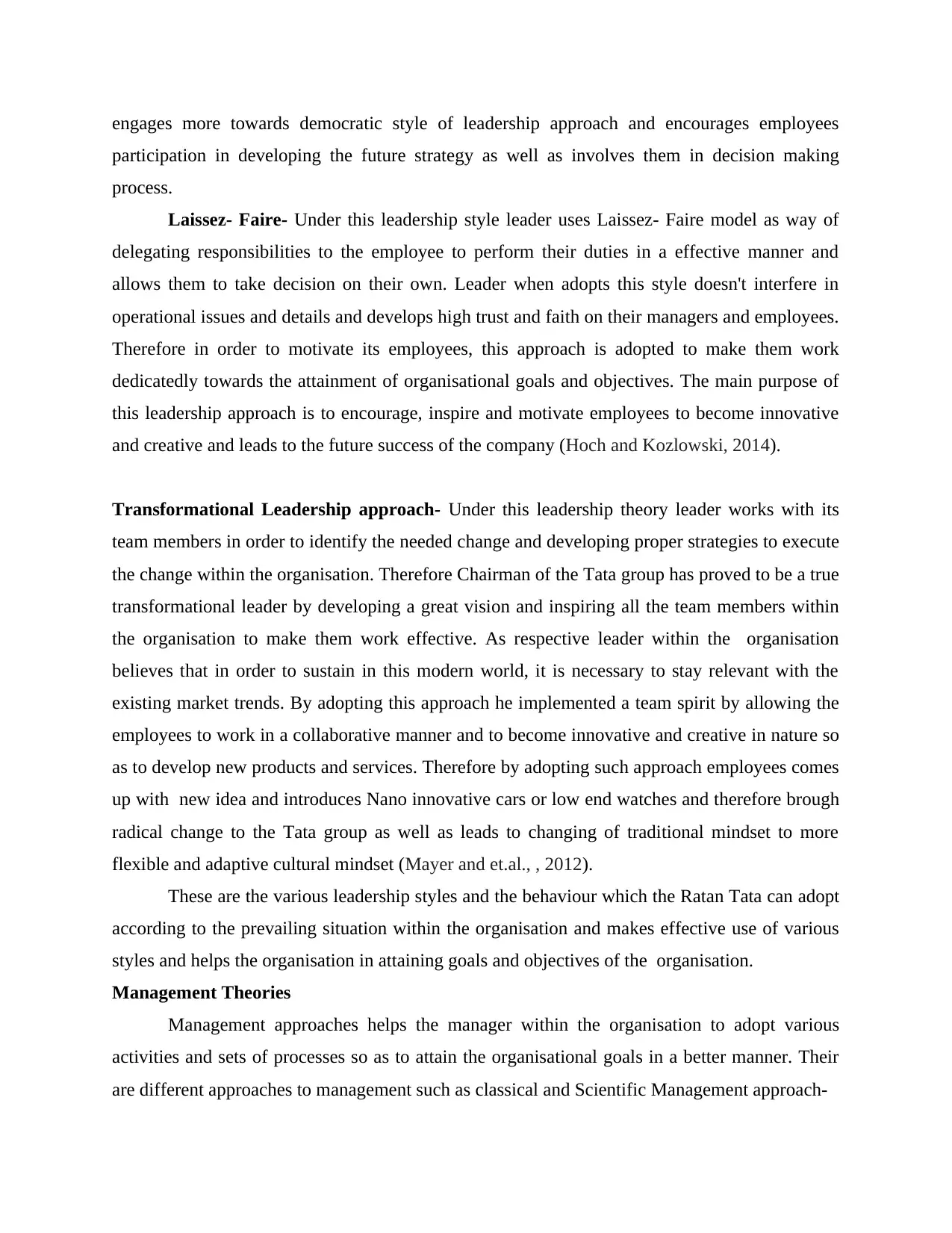
engages more towards democratic style of leadership approach and encourages employees
participation in developing the future strategy as well as involves them in decision making
process.
Laissez- Faire- Under this leadership style leader uses Laissez- Faire model as way of
delegating responsibilities to the employee to perform their duties in a effective manner and
allows them to take decision on their own. Leader when adopts this style doesn't interfere in
operational issues and details and develops high trust and faith on their managers and employees.
Therefore in order to motivate its employees, this approach is adopted to make them work
dedicatedly towards the attainment of organisational goals and objectives. The main purpose of
this leadership approach is to encourage, inspire and motivate employees to become innovative
and creative and leads to the future success of the company (Hoch and Kozlowski, 2014).
Transformational Leadership approach- Under this leadership theory leader works with its
team members in order to identify the needed change and developing proper strategies to execute
the change within the organisation. Therefore Chairman of the Tata group has proved to be a true
transformational leader by developing a great vision and inspiring all the team members within
the organisation to make them work effective. As respective leader within the organisation
believes that in order to sustain in this modern world, it is necessary to stay relevant with the
existing market trends. By adopting this approach he implemented a team spirit by allowing the
employees to work in a collaborative manner and to become innovative and creative in nature so
as to develop new products and services. Therefore by adopting such approach employees comes
up with new idea and introduces Nano innovative cars or low end watches and therefore brough
radical change to the Tata group as well as leads to changing of traditional mindset to more
flexible and adaptive cultural mindset (Mayer and et.al., , 2012).
These are the various leadership styles and the behaviour which the Ratan Tata can adopt
according to the prevailing situation within the organisation and makes effective use of various
styles and helps the organisation in attaining goals and objectives of the organisation.
Management Theories
Management approaches helps the manager within the organisation to adopt various
activities and sets of processes so as to attain the organisational goals in a better manner. Their
are different approaches to management such as classical and Scientific Management approach-
participation in developing the future strategy as well as involves them in decision making
process.
Laissez- Faire- Under this leadership style leader uses Laissez- Faire model as way of
delegating responsibilities to the employee to perform their duties in a effective manner and
allows them to take decision on their own. Leader when adopts this style doesn't interfere in
operational issues and details and develops high trust and faith on their managers and employees.
Therefore in order to motivate its employees, this approach is adopted to make them work
dedicatedly towards the attainment of organisational goals and objectives. The main purpose of
this leadership approach is to encourage, inspire and motivate employees to become innovative
and creative and leads to the future success of the company (Hoch and Kozlowski, 2014).
Transformational Leadership approach- Under this leadership theory leader works with its
team members in order to identify the needed change and developing proper strategies to execute
the change within the organisation. Therefore Chairman of the Tata group has proved to be a true
transformational leader by developing a great vision and inspiring all the team members within
the organisation to make them work effective. As respective leader within the organisation
believes that in order to sustain in this modern world, it is necessary to stay relevant with the
existing market trends. By adopting this approach he implemented a team spirit by allowing the
employees to work in a collaborative manner and to become innovative and creative in nature so
as to develop new products and services. Therefore by adopting such approach employees comes
up with new idea and introduces Nano innovative cars or low end watches and therefore brough
radical change to the Tata group as well as leads to changing of traditional mindset to more
flexible and adaptive cultural mindset (Mayer and et.al., , 2012).
These are the various leadership styles and the behaviour which the Ratan Tata can adopt
according to the prevailing situation within the organisation and makes effective use of various
styles and helps the organisation in attaining goals and objectives of the organisation.
Management Theories
Management approaches helps the manager within the organisation to adopt various
activities and sets of processes so as to attain the organisational goals in a better manner. Their
are different approaches to management such as classical and Scientific Management approach-
Paraphrase This Document
Need a fresh take? Get an instant paraphrase of this document with our AI Paraphraser
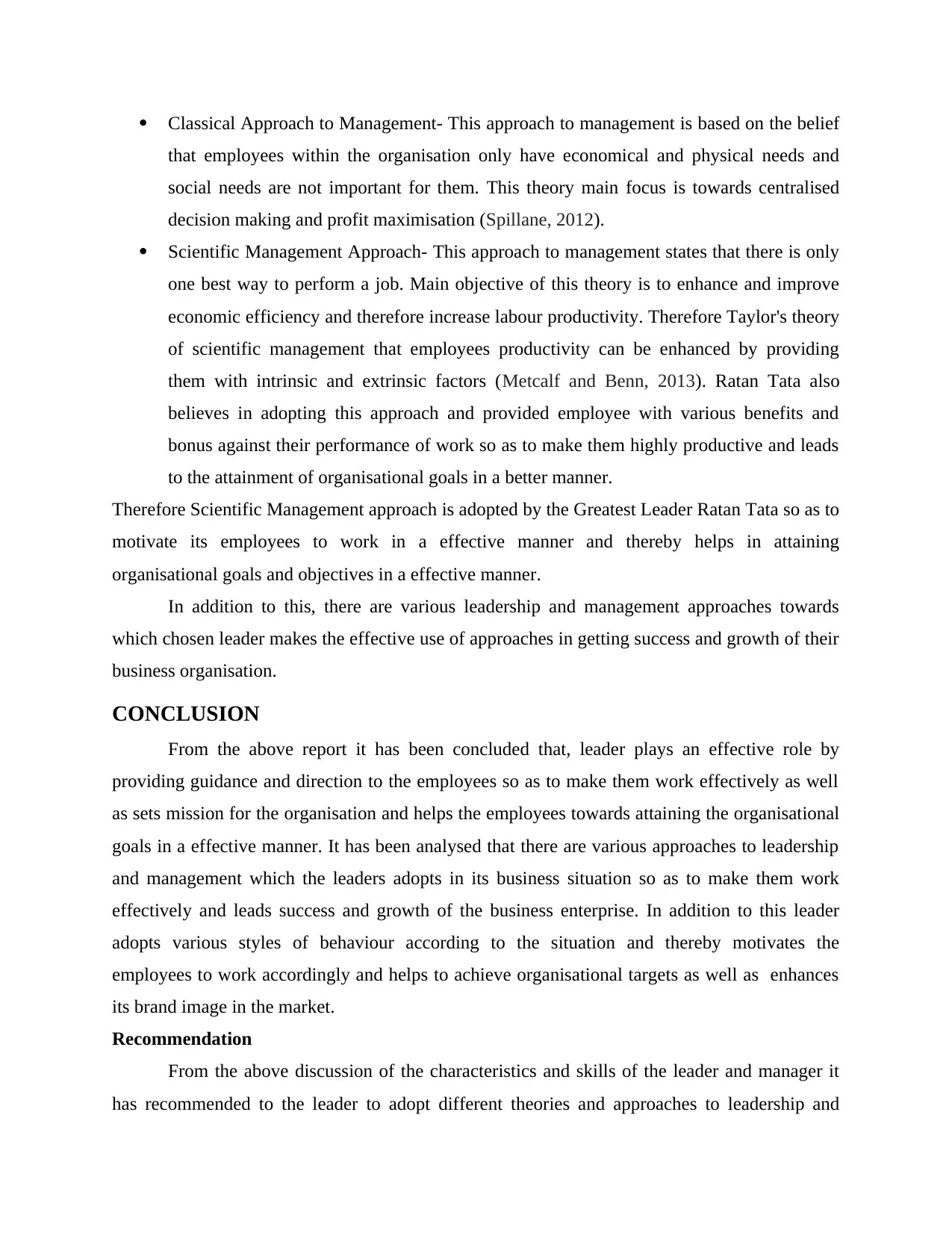
Classical Approach to Management- This approach to management is based on the belief
that employees within the organisation only have economical and physical needs and
social needs are not important for them. This theory main focus is towards centralised
decision making and profit maximisation (Spillane, 2012).
Scientific Management Approach- This approach to management states that there is only
one best way to perform a job. Main objective of this theory is to enhance and improve
economic efficiency and therefore increase labour productivity. Therefore Taylor's theory
of scientific management that employees productivity can be enhanced by providing
them with intrinsic and extrinsic factors (Metcalf and Benn, 2013). Ratan Tata also
believes in adopting this approach and provided employee with various benefits and
bonus against their performance of work so as to make them highly productive and leads
to the attainment of organisational goals in a better manner.
Therefore Scientific Management approach is adopted by the Greatest Leader Ratan Tata so as to
motivate its employees to work in a effective manner and thereby helps in attaining
organisational goals and objectives in a effective manner.
In addition to this, there are various leadership and management approaches towards
which chosen leader makes the effective use of approaches in getting success and growth of their
business organisation.
CONCLUSION
From the above report it has been concluded that, leader plays an effective role by
providing guidance and direction to the employees so as to make them work effectively as well
as sets mission for the organisation and helps the employees towards attaining the organisational
goals in a effective manner. It has been analysed that there are various approaches to leadership
and management which the leaders adopts in its business situation so as to make them work
effectively and leads success and growth of the business enterprise. In addition to this leader
adopts various styles of behaviour according to the situation and thereby motivates the
employees to work accordingly and helps to achieve organisational targets as well as enhances
its brand image in the market.
Recommendation
From the above discussion of the characteristics and skills of the leader and manager it
has recommended to the leader to adopt different theories and approaches to leadership and
that employees within the organisation only have economical and physical needs and
social needs are not important for them. This theory main focus is towards centralised
decision making and profit maximisation (Spillane, 2012).
Scientific Management Approach- This approach to management states that there is only
one best way to perform a job. Main objective of this theory is to enhance and improve
economic efficiency and therefore increase labour productivity. Therefore Taylor's theory
of scientific management that employees productivity can be enhanced by providing
them with intrinsic and extrinsic factors (Metcalf and Benn, 2013). Ratan Tata also
believes in adopting this approach and provided employee with various benefits and
bonus against their performance of work so as to make them highly productive and leads
to the attainment of organisational goals in a better manner.
Therefore Scientific Management approach is adopted by the Greatest Leader Ratan Tata so as to
motivate its employees to work in a effective manner and thereby helps in attaining
organisational goals and objectives in a effective manner.
In addition to this, there are various leadership and management approaches towards
which chosen leader makes the effective use of approaches in getting success and growth of their
business organisation.
CONCLUSION
From the above report it has been concluded that, leader plays an effective role by
providing guidance and direction to the employees so as to make them work effectively as well
as sets mission for the organisation and helps the employees towards attaining the organisational
goals in a effective manner. It has been analysed that there are various approaches to leadership
and management which the leaders adopts in its business situation so as to make them work
effectively and leads success and growth of the business enterprise. In addition to this leader
adopts various styles of behaviour according to the situation and thereby motivates the
employees to work accordingly and helps to achieve organisational targets as well as enhances
its brand image in the market.
Recommendation
From the above discussion of the characteristics and skills of the leader and manager it
has recommended to the leader to adopt different theories and approaches to leadership and
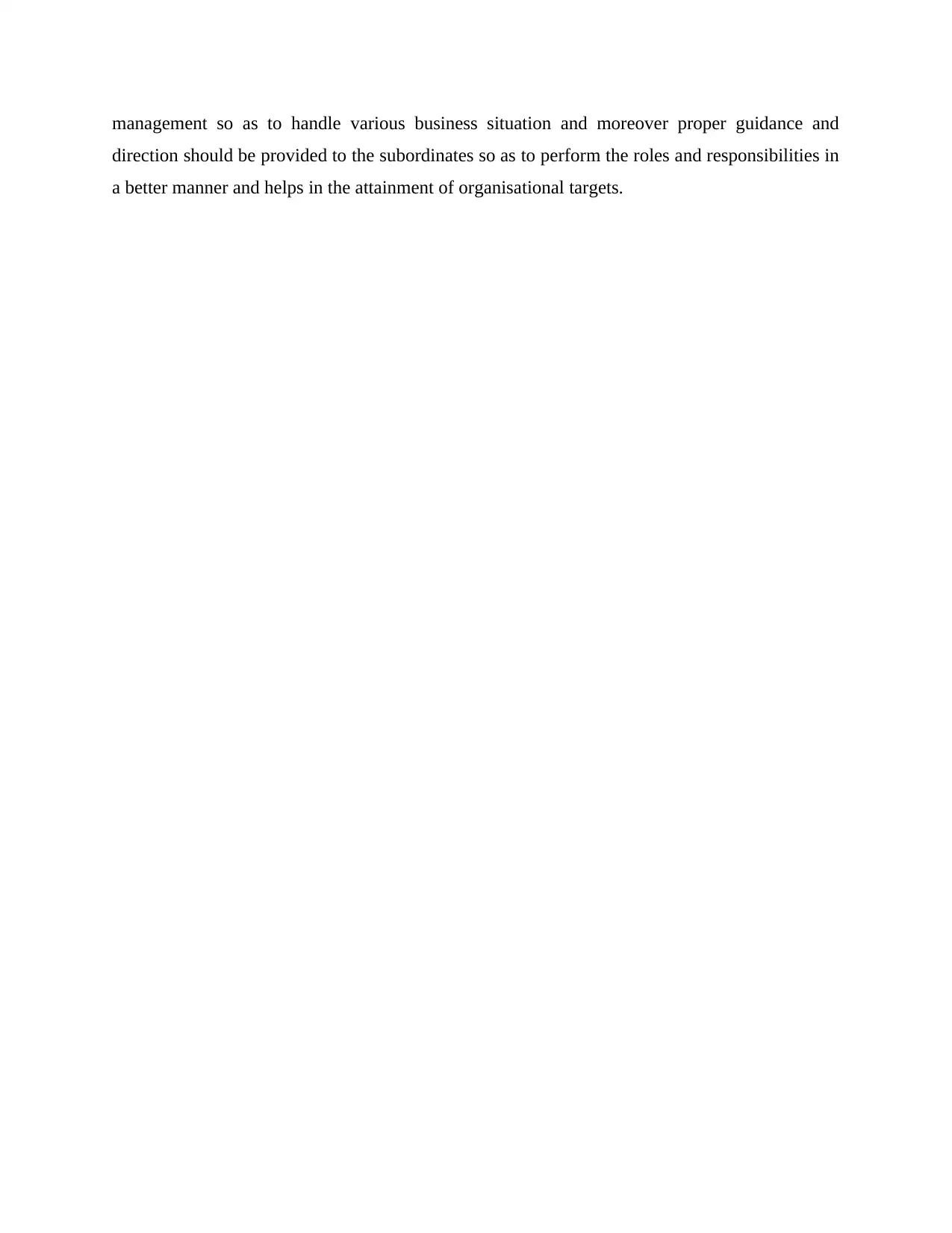
management so as to handle various business situation and moreover proper guidance and
direction should be provided to the subordinates so as to perform the roles and responsibilities in
a better manner and helps in the attainment of organisational targets.
direction should be provided to the subordinates so as to perform the roles and responsibilities in
a better manner and helps in the attainment of organisational targets.
⊘ This is a preview!⊘
Do you want full access?
Subscribe today to unlock all pages.

Trusted by 1+ million students worldwide
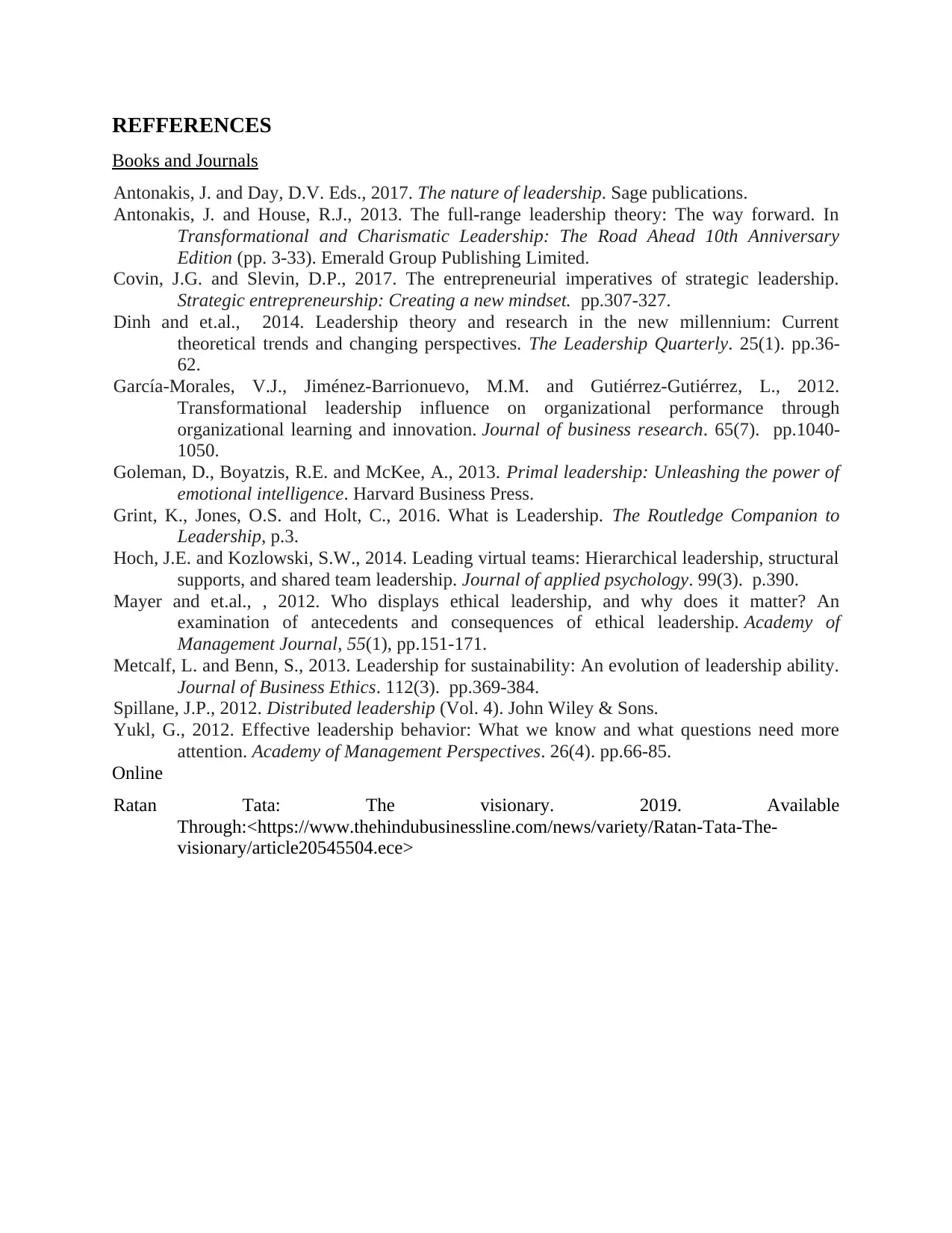
REFFERENCES
Books and Journals
Antonakis, J. and Day, D.V. Eds., 2017. The nature of leadership. Sage publications.
Antonakis, J. and House, R.J., 2013. The full-range leadership theory: The way forward. In
Transformational and Charismatic Leadership: The Road Ahead 10th Anniversary
Edition (pp. 3-33). Emerald Group Publishing Limited.
Covin, J.G. and Slevin, D.P., 2017. The entrepreneurial imperatives of strategic leadership.
Strategic entrepreneurship: Creating a new mindset. pp.307-327.
Dinh and et.al., 2014. Leadership theory and research in the new millennium: Current
theoretical trends and changing perspectives. The Leadership Quarterly. 25(1). pp.36-
62.
García-Morales, V.J., Jiménez-Barrionuevo, M.M. and Gutiérrez-Gutiérrez, L., 2012.
Transformational leadership influence on organizational performance through
organizational learning and innovation. Journal of business research. 65(7). pp.1040-
1050.
Goleman, D., Boyatzis, R.E. and McKee, A., 2013. Primal leadership: Unleashing the power of
emotional intelligence. Harvard Business Press.
Grint, K., Jones, O.S. and Holt, C., 2016. What is Leadership. The Routledge Companion to
Leadership, p.3.
Hoch, J.E. and Kozlowski, S.W., 2014. Leading virtual teams: Hierarchical leadership, structural
supports, and shared team leadership. Journal of applied psychology. 99(3). p.390.
Mayer and et.al., , 2012. Who displays ethical leadership, and why does it matter? An
examination of antecedents and consequences of ethical leadership. Academy of
Management Journal, 55(1), pp.151-171.
Metcalf, L. and Benn, S., 2013. Leadership for sustainability: An evolution of leadership ability.
Journal of Business Ethics. 112(3). pp.369-384.
Spillane, J.P., 2012. Distributed leadership (Vol. 4). John Wiley & Sons.
Yukl, G., 2012. Effective leadership behavior: What we know and what questions need more
attention. Academy of Management Perspectives. 26(4). pp.66-85.
Online
Ratan Tata: The visionary. 2019. Available
Through:<https://www.thehindubusinessline.com/news/variety/Ratan-Tata-The-
visionary/article20545504.ece>
Books and Journals
Antonakis, J. and Day, D.V. Eds., 2017. The nature of leadership. Sage publications.
Antonakis, J. and House, R.J., 2013. The full-range leadership theory: The way forward. In
Transformational and Charismatic Leadership: The Road Ahead 10th Anniversary
Edition (pp. 3-33). Emerald Group Publishing Limited.
Covin, J.G. and Slevin, D.P., 2017. The entrepreneurial imperatives of strategic leadership.
Strategic entrepreneurship: Creating a new mindset. pp.307-327.
Dinh and et.al., 2014. Leadership theory and research in the new millennium: Current
theoretical trends and changing perspectives. The Leadership Quarterly. 25(1). pp.36-
62.
García-Morales, V.J., Jiménez-Barrionuevo, M.M. and Gutiérrez-Gutiérrez, L., 2012.
Transformational leadership influence on organizational performance through
organizational learning and innovation. Journal of business research. 65(7). pp.1040-
1050.
Goleman, D., Boyatzis, R.E. and McKee, A., 2013. Primal leadership: Unleashing the power of
emotional intelligence. Harvard Business Press.
Grint, K., Jones, O.S. and Holt, C., 2016. What is Leadership. The Routledge Companion to
Leadership, p.3.
Hoch, J.E. and Kozlowski, S.W., 2014. Leading virtual teams: Hierarchical leadership, structural
supports, and shared team leadership. Journal of applied psychology. 99(3). p.390.
Mayer and et.al., , 2012. Who displays ethical leadership, and why does it matter? An
examination of antecedents and consequences of ethical leadership. Academy of
Management Journal, 55(1), pp.151-171.
Metcalf, L. and Benn, S., 2013. Leadership for sustainability: An evolution of leadership ability.
Journal of Business Ethics. 112(3). pp.369-384.
Spillane, J.P., 2012. Distributed leadership (Vol. 4). John Wiley & Sons.
Yukl, G., 2012. Effective leadership behavior: What we know and what questions need more
attention. Academy of Management Perspectives. 26(4). pp.66-85.
Online
Ratan Tata: The visionary. 2019. Available
Through:<https://www.thehindubusinessline.com/news/variety/Ratan-Tata-The-
visionary/article20545504.ece>
1 out of 10
Related Documents
Your All-in-One AI-Powered Toolkit for Academic Success.
+13062052269
info@desklib.com
Available 24*7 on WhatsApp / Email
![[object Object]](/_next/static/media/star-bottom.7253800d.svg)
Unlock your academic potential
Copyright © 2020–2025 A2Z Services. All Rights Reserved. Developed and managed by ZUCOL.





